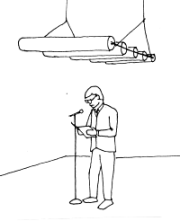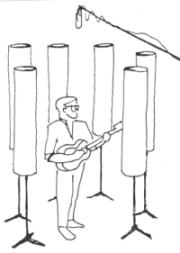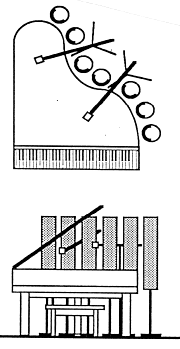
| Preprint No. 2998 6 NEWSCAST, FILM Dubbing, retakes, voice synch and voice over are not without impact on the continuity of the audio track. Both off and on camera vocal tracks are highly sensitive to room acoustic colorations. The variations range from outdoor shots to vocal tracks taken in a closet. One of the audio engineer's jobs is to maintain consistency between the audio and video tracks. A good example of consistency control is found in the production of a television news story. Here the local personality, holding a mic comments on some disaster which is to be seen across their shoulder. The camera pans to another view and the narration continues. The off camera vocal track is not an on-site recording. It was composed and produced back at the TV studio. The voice over simply does not sound the same as that recorded in the field. The life like sound of the omni mic in the free field highly contrasts with the hyper mic used in the small, semi-dead voice over booth. The first major TV station to use QSF acoustics is KTVU, Channel 2 in Oakland, California. It has an award winning news show. Part of their formula for success is the QSF vocal booth technique. For three years (since 1987) they have been using the rapid diffusion/decay rates of a QSF booth where they open up an omni mic in a tiny room 4' x 6' in size and get a voice over mixed with the background sounds that almost perfectly matches full recordings in the field. |
|
| 7 FLYING GOBOS A example of another notable application of the QSF technique involves the very well known show biz voice of Ed McMahon. Remote shoots of his commercials caused a variance in the timbre of his voice. This was unacceptable to the producers as his close mic'd voice was too well known. One of two choices remained, either voice sync everything or stabilize the acoustics of his shots. It's expensive and time consuming to voice sync. Instead, the crew rigged an acoustic cloud using the QSF gobo format, flying just out of camera shot. The boom mic was just below the QSF cloud and the track sounded great. The flying gobo essentially blocked the intrusion of the overhead reverberant sound and provided quite a few early reflections to help smooth over the table and floor bounce effects. This technique is also valuable in the high bay studios. A flying cloud over the free-standing QSF gobo has not only lateral isolation and enhancement but adds in the vertical component for even better isolation and diffusion. |

Fig. 9 - Flying Gobo |
| 8 REMOTE RECORDING Recordings in a large reverberant space can be beautiful but can also be terrible. The engineer tends to move back from the instrument trying for a more natural instrument sound but too quickly runs into the strength of the reverberant field. The QSF gobo method eases the fit by enhancing the direct signal strength while softening the level of the reverberation. The mic is often high overhead. The traps are still set in a semicircle pattern. The variables are the height of the instrument, the height of the traps and the height of the mic. The higher the traps are off the ground, the more energy leaks directly to the reverberant field. The higher the mic is, above and outside the traps, the more it hears the reverb. The reflections of the talent back into the mic produce the diffusive group of early reflections. An additional feature is that the reverberant field is more quickly diffusive due to the spoked nature of the sound source after it passes through the gobo. |

Fig. 10 - Reverberant |
| 9 PIANO GOBO The piano mic is often inside the open lid of the piano top. Unfortunately this lid/sound board is not only good for projecting sound out, but also good at collecting sound from the outside which the mic also picks up. Often, the piano is draped in moving blankets. A gobo can also be used to increase the signal at the mic and reduce the intrusion of noise and echos. The QSF gobo for a piano sets traps along the open side of the piano with the reflectors inwards. Interior sounds are multiple reflected while sound from the outside is attenuated. Mic placement can be eased away from the strings without degrading the recording. An aside: Piano sound boards are essentially parallel to the floor. This allows the setting up of standing waves. Very irregular loudness effects in the middle C octave and above are directly attributable to this effect. About 1/5 of professional piano practice setups include some sound damping material under the piano. Best results are developed with acoustic materials that scatter mids and highs but damp 200 to 400 Hz. A couple of traps used for gobo purposes can be placed on the floor below the piano, with reflectors up for best results. |

Fig. 11 - Piano Gobo |
| 10 SPEECH TRAINING GOBO This experiment was performed with the speech therapy department at the University of California, San Diego. A speech training table is typically set out in a larger room. It is the size of a card table. Four Traps were added with the reflectors facing inward. Speech training ensued with the hearing impaired. The single bounce off the table creates a comb filter effect. By adding 4 additional reflectors the comb coloration effects reduced. The listener tries to imitate sounds. To mimic comb filtered speech is inappropriate and would be judged incorrect by the teacher. The multiple reflected signal is a more honest and accurate signal to imitate. When speaking, the student hears the sound of their own voice better due to backscattering off the reflectors. Acoustic feedback increases the rate of learning. The teacher and student both speak through the same "chamber". The teacher can also better hear detail in the speech of the student due to the enhanced acoustic coupling by this set up. Hearing impaired seem to hear better with one ear oriented directly toward the speaker. In general, they are also very susceptible to distraction by sounds coming in from the side. In this configuration, sound from the side is blocked and replaced with a reflection of the speaker's voice. Traps to the left and right of the speaker also block room noise and help the speaker's voice stand out more distinctly. Additionally, the traps near the speaker help to block directionally competing sound. Not only does the gobo signal enhance speech but it reduces distraction. An interesting aside is that these Traps form somewhat of a "blinder" for the student. Hearing impaired are easily visually distracted, as are the learning disabled. This table top gobo provides a substantial degree of visual barrier effect allowing the student and teacher to be in better contact. |

Fig. 12 - Listening Function 
Fig. 13 - Monitor Function 
Fig. 14 - Isolation Function |
| 11 INTELLIGIBLE LISTENING The dynamic level of listening for the hearing impaired is limited and compressed. For example at 50 dB,A, sound might really be at the threshold of audibility for some frequency range yet at 80 dB,A the weak frequency range would sound as loud as with any unimpaired ear. In addition to spectral threshold and dynamic range problems the hearing impaired very often lose the ability to discriminate one sound above others in a crowded, noisy sound field. Echolocation is the ability to corrolate the sounds from some particular direction using signals into both ears. Current practice in hearing aids is limited only to bandwidth level controls. Phase and time alignments are not yet available. The saturated sound fusion acoustic space provides remarkable listening benefit for the hearing impaired. This is most especially evident in contrast to the hearing aid and the mic/headset options presently in common use. All three factors found in the QSF acoustic space are an aid to listening. 1. The RT-60 is fast, Both external and internal room noise is rapidly attenuated so as to not be competitive with the signal. 2. The sound fusion window is saturated with diffuse ambience so the direct sound is enhanced not in level but over time. 3. The acoustic space is wide and smooth so the received signal remains consistent despite variations in listening and speaking position. Because the hearing impaired are quite vulnerable to room noise masking of the intended signal, a quiet and non-reverberant room is always recommended for better listening results. Intelligibility tests show an inverse correlation between intelligibility scores and RT-60. This leads to the conclusion that an anechoic space is the best space for listening. Although the tendency for better listening performance lies in the anechoic direction, it is agreed by researchers that some ambience is better for listening than none. This leads to the curious conclusion that a less than "perfect" intelligibility rating might actually be the more intelligible for listening. Not only has this come up in the field of speech intelligibility- but in the present work. The reflections that could enhance intelligibility should not be echo effects, outside the time windows of 50 ms. They would have to be very early reflections that are corrolated with the direct signal. Again, reflections used in correlation processes must be coherent, not random phase type reflections. In intelligibility testing, for example with Techron, % Alcons work, the direct/reverb ratio must be established. The D/R ratio varies depending on how many milliseconds after the direct signal that the cursor for calculation is located. It is generally agreed that +50 to 70 ms is a good location for D/R ratio calculations. |
|
| 12 HIGH INTELLIGIBILITY LISTENING ROOM Beyond the technical aspect of intelligibility measurements is the autonomic response characteristics of the human listener. In the dry anechoic room, without reflections, sound levels vary almost violently. This is evidenced by the continual contraction of inner ear muscles. Loud sounds cause an autonomic flinch reaction by the muscles of the inner pap that protect the ear from damage due to further loud sounds. The Fletcher Munsion curves are ample evidence of this limiter action. However, the reaction time for this process is 1/10 second. The staccato of speech in a very dry room produces a rapid sequence of 70 dB level changes and the listener is plagued with a distracting and tiring flinch reaction. The saturated sound fusion window of 50 to 40 ms provides just enough ambience to reduce the autonomic flinch responses to a minimal level. But even here the lack of echoic ambience results in some dynamic level flinch, a loudness suppression reaction. For non-recording purposes the diffusive ambience probably should be stretched to 100 ms~ lightly into the echo region. The statistical sound field of a diffusive space allows the listener and/or speaker to move positions and the received sound to remain the same. An inexperienced speaker using a microphone that is hardwired or IR coupled into headsets injects a new problem into communication - mic position relative to the speaker. For the teacher of a group of hearing impaired to wear headphones inhibits the ability to listen to the students' response. The students cannot be mic'd and so the teacher does not wear the headset. Headphones are promoted for learning speech because they reduce the intrusion of unwanted and distracting signal. But they exclude the airborne sound of the student's voice to oneself. Ultimately, this will be the primary feedback mechanism one has aside from bone conduction. In the coherent diffusive sound field of the QSF space, each student can wear hearing aids and hear the teacher relatively equally, irrespective of student or teacher position. Conversely, the teacher hears a student's speech as best as possible, so does each student. This is a direct consequence of the wide, open statistically diffuse, ambient sound field of the QSF technique. The student has to practice speech in a space that allows them to hear themselves on their own hearing aids. It is the only feedback system they will carry with them into the "real world". Hearing aids pick up a lot of room ambience in a regular room. There is no ambience in a dry room. The Quick Sound Field technique is an acoustic space that minimizes room noise and maximizes acoustic feedback. Not only in promise but in practice the QSF type sound field is a significant contribution towards improving the quality of life for the hearing impaired. |
 Fig. 15 - Listening Room |
| 13 HISTORY The very first QSF space was assembled spontaneously by one recording engineer in 1984 who happened to have a lot of modular acoustic units at hand in the studio. Since then many spontaneous QSF gobo applications have been reported by users in the field. The only common ingredient is that a variety of modular acoustic units were available and the engineer's ear leads the way. The formal development of the QSF method took place in 1987 when a sampling booth design was needed. The traditional dry room gave unacceptable signal for this level of processing. The acoustic signature of the first booth was successful and a lighter weight version of the booth continues in its place. The original booth has found a home in a west coast recording school. Within months after the initial QSF sampling booth was produced, a number of studio projects included this booth technique. Each time, the vocal talent in the studio discovered this new acoustic space, they insisted on recording in it. Often, a second smaller vocal booth had to be built to put the sampling room back on line with its intended use. The most notable QSF sampling room was picked up by musician Pete Townsend of the WHO. He was so impressed with this new acoustic space that he endorsed it, without remuneration to help encourage other engineers to try it. His room remains at Eel Pie Studios just outside of London. Because of the early pioneering efforts of forward thinking, recording engineers, the Quick Sound Field has developed into a dependable recording technique. |
|
| 14 CONCLUSION The acoustic signature of colorless "ambience" has been presented. Acoustic systems to produce this effect have been developed, with five years of experience and testing in a wide variety of applications. The consensus is that this Quick Sound Field method is a major improvement in mic technique. The Quick Sound Field method uses the Haas Effect - this time involving statistical diffuse reflections instead of discrete reflections. The QSF establishes a fundamental distinction between coherent and incoherent reflections. While random phase, incoherent reflections may be acceptable in the realm of echo control, they produce masking within the Haas sound fusion time period. Historically, an inordinant amount of technical expertise and effort has been focused on the control room acoustic. Now, attention turns to the mic. The Quick Sound Field is the next logical step in comprehensive development of the studio acoustic. © 2009 Acoustic Sciences Corporation. All Rights Reserved. |
|